#Gilgamesh was the most relatable
Explore tagged Tumblr posts
Text
This but also: what’s more relatable than “fuck fuck fuck what am I doing with my life, everything I’ve ever cared about seems lost to me or meaningless, and what I’ve chosen to base my life around (God, for Dante) seems lost to me?” combined with “I’m gonna (literally) roast all my enemies, anyone who’s ever wronged me, and that one dude I just don’t like, in writing, for everyone to see”?
The second part is basically Reddit’s AITA where Dante is clearly just making a post to show that someone else (many, many people honestly) is an asshole.
And then he gets to journey back to himself and his convictions and the person he wants to be, and that’s…pretty fucking relatable and aspirational.
And also he’s super gay for Virgil and it’s very funny.
just seen someone criticize the divine comedy by saying that it's not relatable which is of course incommensurably stupid because relatability should never be the only criterion through which one can judge the validity and quality of a piece of work &c but also. just because you tedious unimaginative losers have never been on a journey to hell and purgatory with your long dead favorite writer doesn't mean others haven't. happened to me
#I mean the schisms and politicking is admittedly a bit abstruse to our modern perspectives#and the medieval Catholic worldview is admittedly way more foreign to most Millenials and whatever the next generation is calling itself#than fucking Gilgamesh#which incidentally in terms of epics I’ve taught#Gilgamesh was the most relatable#then the Odyssey#then Beowulf (kids really struggled with that one)#then the Inferno (kids agreed with the person OP is railing against that it’s not relatable)#(though I think they just meant too fucking complicated)#(the emotional content is very straightforward but hoo boy those medieval Catholics)#makes me want to teach Paradise Lost and see if it’s even more incomprehensible#because so far the further back in history it is#the more the kids could get into it#and the closer to our present day#the more incomprehensible they found the worldview
41K notes
·
View notes
Text
Ancient societies portrayed deep, intense, passionate love between 2 men, like Gilgamesh and Enkidu & Achilles and Patroclus, not because of like... gayness per se, but because gender divisions were so severe and cultural opinions of women so low that it was believed men could only achieve deep, real love and form lasting, powerful relationships with other men. Ancient Greeks practiced pederasty and male/male companionship not because the whole society was gay asf (unless...................?) but because it was the bond between 2 men or a man and a boy that was considered the most important emotional bond a man could have, and formed a large component of his socialization and cultural learning. Women in these societies were not social, cultural equals on any level. There was an idea that an Athenian woman should only leave her home twice: once to go to her husband's house on the day of her wedding, and the second time as a corpse to be buried. In ancient Mesopotamia, a woman or girl who was physically outside the home was considered sexually available, equivalent to a prostitute, with no social clout or value. (None of this means, btw, that women never left the house, etc. but these were the cultural attitudes all women contended with regardless of class.) It can be frustrating to see people on Timblr weeping and moaning over the power of these love stories--which, I can relate to, I cried the first time I read the Iliad! But given the intense misogyny on this site as a whole (funny since it's the female website), it feels like yet another symptom of the closed-circuit minds on here that identify most passionately and intensely with men and relate to men's struggles, men's feelings, men's partnerships with each other, in a way that they can't or won't begin to do for women.
1K notes
·
View notes
Text
Bharani : the birth of Venus.
Part 1
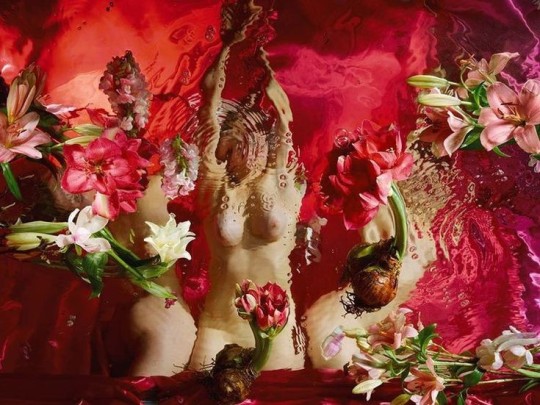
Let's talk about ancient godesses of love and Bharani nakshatra.
I will base my research on the legend of the dead and resurrected god present in many religious myths coming from the middle east (ps : i'm sorry in advance for the grammar, syntax or spelling mistakes that you may find in this post, english is not my first language)
Bharani, situated in the heart of the rashi of aries is governed by Shukr: Venus but also by Yami and Yama in vedic mythology who are twins and gods respectfully of life and death.

Yama, the main deity of Bharani is said to be one of "8 celestial gatekeepers, who guards eight directional doorways or exits through which souls travel from an earthly plane to other planes of existence" making him the lord of Dharma since at one's death, he decides basing on his actions in what plane should one reincarnate.
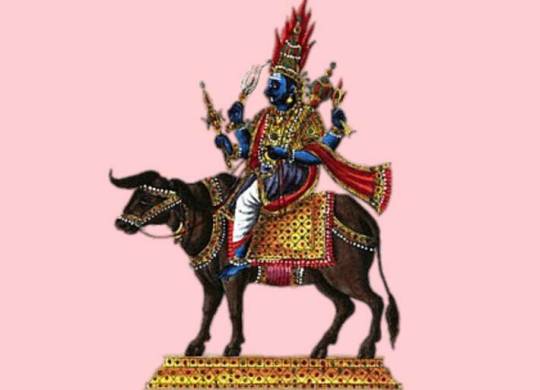
Since Yama is responsible for directing the flow of life on Earth the association between bharani and the yoni becomes evident: the female reproducting system serves as a portal for souls to take on a physical form. So bharani as Claire Nakti perfectly described it relates to the feminine ability to receive, hold, nurture and ultimately transform through the womb.
Because Bharani aligns itself with all the feminine qualities by excellence it makes sense as to why Venus is it's ruler.
Venus is the roman name for the goddess Aphrodite: in greek mythology. She is said to be the goddess of love and beauty at large but also the goddess of war and sexuality. First because the ancient greeks saw the duality that links love to war and how they seem to come together through sex.
Also, Aphrodite is said to be born from the sperm of Ouranos when his testicules got cut by his son Saturn as he was always feconding Gaia, the Earth and causing her distress: he was acting cruel regarding their children. The sperm of Ouranus got mixed up with the foam of the Ocean creating Aphrodite which means "risen from the foam". So it was interesting to see that as Shukr also means sperm in sanskrit and it shows the origin of Venus as a fertility goddess too.

This conception of Aphrodite directly links her to ancient goddesses of love such as Ishtar or Inana in Mesopotamian/summerian mythology or Isis in egyptian mythology. Most of the time, these goddesses are the female counterpart of a god that was once mortal, got cursed, died and then came back to life for them to form an immortal couple.
In the case of Ishtar, her consort is Dumuzi or Tammuz and Osiris is the consort of Isis.
In Mesopotamian mythology :
Ishtar or Inana in sumerian is the goddess of love and sexuality, beauty, fertility as well as war because of her status as a " bloody goddess" mostly refering to her character in plenty of myths.
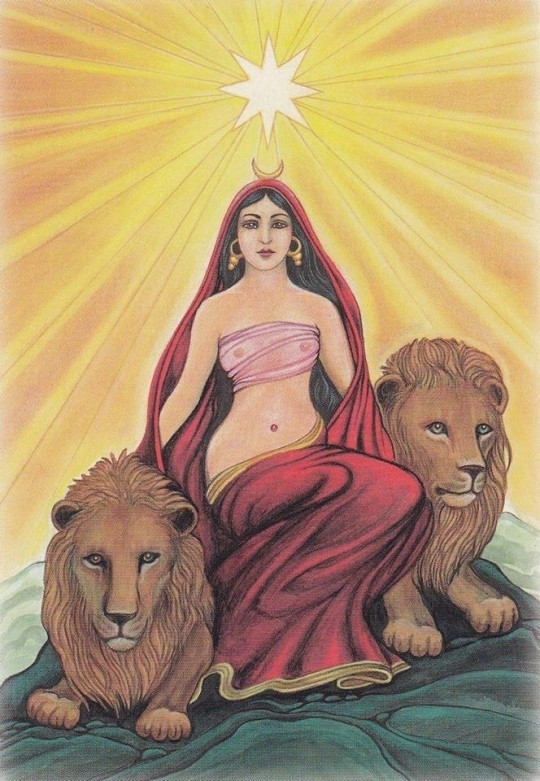
For example: in one story, she became infatuated with the king Gilgamesh, but the latter knowing her fierce reputation, refused her advances. As a result she got furious and unleashed the celestial Bull on Earth which resulted in 7 years of plagues. This celestial bull was later defeated by Gilgamesh and Endiku, and its corpse was throwed in front of Inana. Blinded by rage, she decided that as a punition Enkidu must die and sad at the death of his bestfriend Gilgamesh began his journey to find a cure to Death.
Bharani is a fierce or Ugra nakshatra meaning that its nature is agressive, bold and assertive in pursuing their goals. They are ruthless in the process of accompling what they desire the most and are inclined to extreme mood swings that can result in them to be "blinded" by their extreme emotions perfectly expressing the passionate character of Venus and her other equivalents in differents pantheons of antiquity.
Inana/ Ishtar's story with Dumuzi/Tammur begins as she was convinced to chose him by her brother Utu. Then she got married with the shepphard Dumuzi instead of whom she prefered the farmer: Enkinmdou. During the courtship, Inana prefered the fine textile of the farmer and his beer rather than the thick wool and milk of Dumuzi. The preference for the shepphard illustrates that at the time the Mesopotamian civilisation was known for their proliferent agriculture with the egyptians in the region, so this myth encapsulate the opposition between nomads and sendatary people at this specifific time period.

By the way, another symbol of Bharani is the cave and traditionnaly, the cave was used as a storage room for food. Also Bharani's purpose is Artha so these individuals are motivated to accumalate resources and provide safety and security, so Bharani can be linked to the exploitation of natural ressources like the soil illustrating the preference of Ishtar for the farmer. This is reinforced also by its Earth element.
So coming back to the myth, in a mesopotamian text called Inana's Descent to the Underworld, the goddess goes to Kur (hell) with the intent of conquering it, and her sister Ereshkigal who rules the Underworld, kills her. She learns that she can escape if she finds a sacrifice to replace her, in her search, she encounters servants who were mourning her death however she finds Dumuzi relaxing on a throne being entertained by enslaved girls. Enraged by his disloyalty she selects him as a sacrifice and he is dragged to the Underworld by demons.
He is eventually resurrected by Inana and they become an "immortal couple" as he may only come back to life for half of the year, being replaced by his son (?) who is also his reincarnation for the other half of the same years, so describing the cycle of regeneration of life.
Other mythologycal stories of goddesses in the near east describe a similar patterns:
The goddess Asherah is described as being the mother and the lover of her son Adonis.
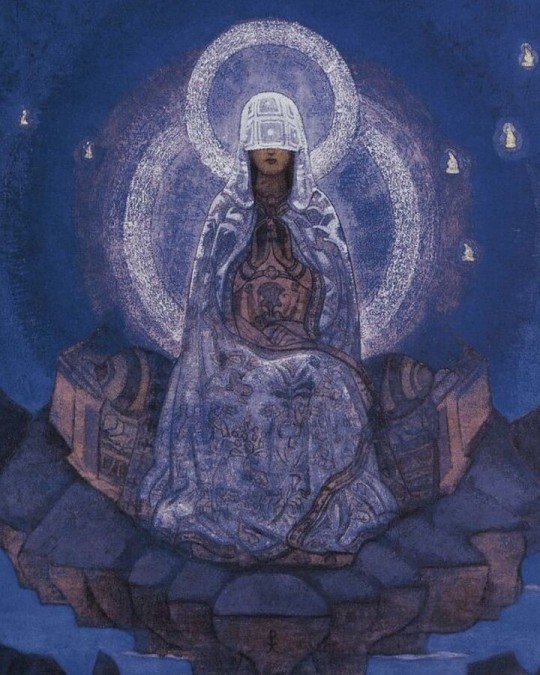
The goddess Cybele in the phrygian pantheon takes the form of an old woman as she described as the mother of everything and of all. And at the same time she is the consort of Attis who his her own son (wtf ?)
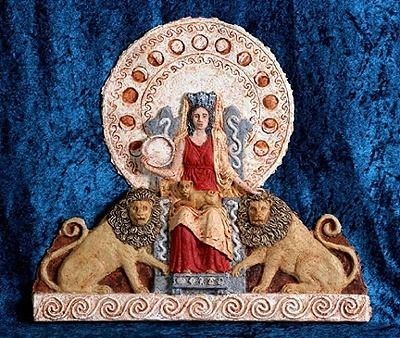
Also, Yama and Yami are implicated in a incestuous entanglement where his sister Yama wanted to lay with him however he refused establishing himself as a god with an infaillible moral campus.
All of these representations illustrate the relation between the masculine and the feminine, life and regenration which are all topics related to Bharani nakshatra. Women by their capacity to give life are seen as the source of life and therefore are eternal as they are able to regenarate themselves through daughters which are identical to them whereas man who is unable to reproduce by himself, is therefore mortal feels the need to associate with her to resurrect through a son who is identical to him. Bharani exiting as the embodiment of the link between "the father and the offspring" which is the feminine vessel.

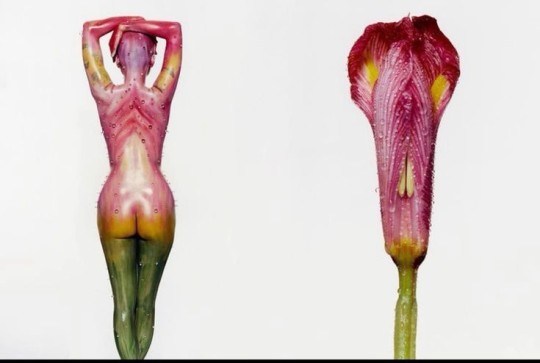
So this is certainly part 1, I think that these ancient myths are where Claire Nakti found her inspiration for her series on Bharani.
#vedic astrology#cinema#coquette#astrology#vintage movies#aesthetic#coquette dollete#fashion#vintage#movies#greek mythology#roman mythology#ancient egypt#bharani#chitra nakshatra#purva bhadrapada#purva phalguni#cowboy carter#venus#adonis
236 notes
·
View notes
Note
Hi, i love your blog, can i ask what Gilgamesh's name mean? I can't find it
Hello, and thanks! The name Gilgamesh 𒀭𒄑𒂆𒈦 is actually the Akkadian name, and is derived from his earlier Sumerian name, most often rendered Bilgames 𒀭𒄑𒉋𒂵𒎌. Bilga 𒉋𒂵 means "ancestor, elder relative", as in someone you're related to who's older than you, derived from pabilga 𒉺𒉋𒂵 which means "paternal grandfather, paternal uncle" or possibly another male paternal ancestor. Mes or mesh is "hero, young man, masculine". (This word is written several ways in cuneiform, but in this name is most often 𒎌).
This combination is most often read to mean something like "male hero-ancestor, masculine elder, young heroic man who is also a paternal ancestor". However, the exact type of ancestor he's meant to be is a point of contention, and who exactly he's an ancestor to. And his name was also spelled a number of different ways which can have their own interpretations.
70 notes
·
View notes
Text

Read this post from the previous night first!
-
The night was dreamless, and like RIDER said- you were up at daybreak. There wasn't much time to say goodbye to the city, and things were already in motion. No formal announcements had been made yet, but PTOLEMY would be attacking the Crimson Citadel, DURYODHANA would begin his assault, and IZOU would be en-route to his assassination target…
To conserve magical energy, RIDER only summoned four horses.
The horses were organized rather simply. You and KUKULKAN shared a horse. NERO and CONSTANTINE shared a horse. GIUSEPPE and MUSASHI shared a horse. And AVENGER had one to himself, which he didn't seem to mind.
And then-- you were out on the road.

CONSTANTINE: "Aah…" KUKULKAN: "Hey, that's a rare relaxed face from you! I guess a Rider's gotta feel more comfy when actually riding, huh?" CONSTANTINE: "Hm? Well, partially. I suppose all of this reminded me of when I was a young man. I always did love horseback riding, and I traveled about plenty." GIUSEPPE: "Hm, I can relate. I didn't travel much on horseback, but on my adventures I did love to just see the world pass by…" NERO: "Both of you are bizarre… Horses and chariots are terrible on the you-know-what! I only used them when needed." SALIERI: "…The 'you-know-what'?" NERO: "The butt, Avenger! Don't act as if mine doesn't exist, as surely you've had a great many chances to look upon it." SALIERI: "Ugh." MUSASHI: "Well, sorry to your Royal Rear, but we've gotta get a move on. Hyah!" NERO: "Ghh… that settles it! Constantinus, move! I'm going to sit side-saddle! It'll be more comfortable!" CONSTANTINE: "Woah! Antecessor-- don't squirm while we're still moving! Please decide these things beforehand!"
-
…It seemed like you were traveling with a lively party.
That being said, while it wasn't the most subtle group, six Servants grouped together on the Solar Cell deterred most enemy programs. If you were attacked, it certainly wouldn't be from any small fry. That being said, it would definitely be harder to sneak around with a group this large. If you wanted to do more subtle operations, it may be better to bring less Servants.
Two days passed by quickly and easily. Late nights and early mornings made the trip simple and quick, though you were feeling a bit wiped at the end of it all. Your Servants seemed fine… but that seemed more because they were supernatural ghosts that didn't need any sort of food or rest. You, on the other hand… well, maybe at one point you could keep up with them, but that time was quite a while ago.
Still, from what you discovered from training with KUKULKAN, maybe regaining that power wouldn't be impossible.

It was late by the time you reached the 'Sunbeam Row'.
It was quieter and smaller than the other two major cities you've visited, though it was hard to get a grasp on the town at this hour.
KUKULKAN: "So… about finding the King of Heroes?"
NERO: "It's Gilgamesh. It shouldn't be that hard."
MUSASHI: "If you say so..."
CONSTANTINE: "…We'll have to search in the morning. Let's find somewhere for our Masters to rest first."
You remembered that CITT mentioned an inn and tavern. Biitum. It was easy enough to spot, as you entered.

There were a few patrons, but it was rather empty. Your… eccentric-looking group drew a few stares, but nothing hostile. Once you had settled in a bit, they went back to what they were doing.
You heard a woman's voice coming from the back.
WOMAN'S VOICE: "Ah- are those patrons? I'm sorry! I'm busy in the kitchen, could you please go handle them?"
YOUNG BOY'S VOICE: "Okaaaay~!"
A young man bounded out of one of the back rooms. There was a youthful innocence about him- the type of person that seemed to be trustworthy by default. If there was one thing that made him 'off-putting', it was the deep ruby red of his eyes, and the maturity in his gaze that didn't always align with the youthfulness of his face.
He seemed like a polite young man, nonetheless.

YOUNG MAN: "Good evening, thank you for coming to Biitum! It's your lucky day, because since everyone's left for the Flaming Bout, we have a ton of empty rooms! Please stay and buy lots, so me and my big sis have enough money to eat!"
WOMAN'S VOICE: "Gil!"
You heard a name shouted out, scolding the young man.

GIL: "Ahaha! I'm just joking!"

GIL: "But... oh man… We don't often have so many pretty ladies here, I'm feeling a bit flustered!"
…You realized that he wasn't paying any attention to you, nor any of the men in your group. The women, however, were quickly charmed.

MUSASHI: "Aww… What a little cutie! I just wanna ruffle his hair!"
KUKULKAN: "I never had a little brother before… ah, is this what it feels like to want to pamper someone?"
NERO: "Well, it's simply natural to be flustered in my presence! You're a wise young man, certainly!"
As they fawned over the young man, the others stood off to the side with varying expressions of skepticism on their faces.

SALIERI: "...Precocious little ragazzo, isn't he?"
CONSTANTINE: "Very much so. Still, room vacancies come in our favor. Perhaps the average prices will be lowered."
GIUSEPPE: "As tourists who don't know what the average price is… it's best to be careful about those sorts of assumptions."
18 notes
·
View notes
Note
I maintain the reason that there's so much art of fem!gilgamesh (not Angelica, but actual fem!gilgamesh), far more than rule 63 of any other fate character, is bc there's a lot of straight guys out there who don't want to admit they're attracted to gilgamesh so they make him a girl instead
there's actually a more straightforward reason!
to understand why f!gil is so popular, we first have to talk about a now-defunct doujin circle called FAIRIAL and an april fools joke

youtube
(my favourite understated joke is how the characters are talking over each other even more than is normal for a PV lol)
FAIRIAL and WAVE were already pretty popular, so when they released Fate/Protoreplica, an april fools joke that was sort of a "remake of Prototype" with elements of Fate/stay night and Fate/Zero, people lost their shit
there were fake CV previews, character designs, bios, and even a full soundtrack later on (which, of course, was the entire point of this. the joke is that protoreplica was fanfic made to promote a soundtrack arrangement album)
but let's pull back a little. how's this relate to female gilgamesh? well,


included in that announcement were two designs for female gilgamesh, complete with voice clips. if you've ever wondered why so much f!gil art features shirou dressed like a catholic priest, it's because it's a protoreplica reference
the design was so popular that a fullbody illustration was requested. naturally, it was provided in the post explaining the joke a few days later
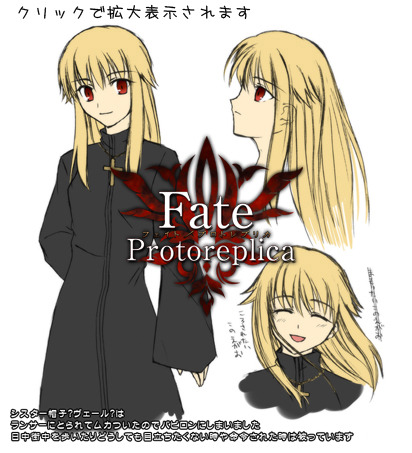

perhaps most importantly to its staying power, someone asked if it was okay to make secondary work inspired by protoreplica, to which FAIRIAL responded "lol yeah we don't own fate anyway, so we have no claim over this"

a couple female gilgamesh designs had already been floating around for a while before this, but after protoreplica, the name 姫ギル (himegil, or princess gilgamesh) became so synonymous with the one from protoreplica that the pixiv tag translation still specifies it to this day

so the real reason that f!gil is so popular is that she's a meme who caught on early enough to cement herself in fandom memory pre-FGO
226 notes
·
View notes
Note
Scuttling into ur askbox like a little beetle
i think i recall you reblogging/posting things about geography and culture + human effect on it - I vaguely recall a piece of art where it showed a blurred out, cropped piece of people fighting, and focused instead on the flora in the scene.
ANYWAY! getting back on track. seeing that piece inspired me to take a course this semester called "people and the land: cultural geography". and the whole reason I came to your askbox was to ask if you had any suggested reading materials? We'll get stuff in class ofc, but I am curious to see if there's any bias of materials on the prof's side vs someone else.
Phew that was a long ask. thank you o/!
That sounds like Liz Anna Kozik’s piece : D So happy it stuck with you! I love her work!!
As for your ask, what an awesome class! Land-human relationships are my bullshit, and I really enjoyed my own cultural geography class.
Thinking back on my schooling, I would say about 70% of my classes fell in with the “everything is awful and humans are the worst” narrative, and the other 30% made time for land-human relationships other than the extractive hellscape that most people currently live under. So, full disclosure, when I think of “bias,” that’s what I think of. You grow up in the miasma, it’s hard to imagine that there’s any other way of living. It’s also hard to say without knowing the professor, but I think, in general, it’s good to be mindful of who is or isn’t telling the story.
ANYWAY. All that in mind, here’s some articles about people-land relations that I think are neat:
The Environment and Society portal - I like their digital exhibits especially. I remember enjoying Oceans in Three Paradoxes and The Northwest Passage. Great place to wander around and pick a random article that catches your eye.
Of Deserts and Decolonization: Dispelling Myths About Drylands – obligatory desert propaganda. An article looking at how colonial mindsets about deserts disrupt existing relationships and hurt both people and land, and also how those attitudes shape environmentalism/conservation/etc. still today.
The Miracle of the Commons – lovingly challenging the Tragedy of the Commons with a creative solution to poaching and human-animal conflict in South Africa, Zimbabwe, and Namibia. Great article to sit in discomfort about (productively!)
Biodiversity: The Variety of Life that Sustains Our Own – Contains one of my go-to examples when explaining how humans can be good for land and biodiversity, the story of Quitobaquito Springs (and its sister spring Ki:towak, though the author doesn’t mention it here.)
The Environmental History Timeline - just fun to look at, especially the further you go back. It’s funny to spot where a young branch of history is trying *really hard* to reframe how academia thinks about the past, by bringing the invisible landscape forward:
2700 BCE — Epic of Gilgamesh describes vast tracts of cedar forests in what is now southern Iraq. Gilgamesh defies the gods and cuts down the forest, and in return the gods say they will curse Sumeria with fire (or possibly drought). By 2100 BCE, soil erosion and salt buildup have devastated agriculture. One Sumerian wrote that the “earth turned white.” Civilization moved north to Babylonia and Assyria. Again, deforestation becomes a factor in the rise and subsequent fall of these civilizations. (Perlin, 1991). 2700 BC — Some of the first laws protecting the remaining forests are decreed in Ur, Messopotamia. (Grove, 1995).
^^^ fucking around and finding out forever and ever and ever.
#thank you for reaching out! I hope you enjoy your class!#i hope i understood this correctly and that these are helpful. and if not. well. there was an attempt 🤪#love this land#for science
88 notes
·
View notes
Text
My attempted summary of Fallen London lore as I related it to my friends, who have never played Fallen London (spoilers)
Stars are sentient and they hate you. A giant space crab who works as the Sun's messenger fell in love with the Sun, and was sent to give another star a love letter from the Sun. The star turned the Sun down, and the space crab freaked the fuck out and decided to come up with a madcap plan to win the Sun's love by convincing it that love is real, so it went down to this underground cavern filled with weird, freaky Lovecraft shit. Its servants, a horde of alien space bats called Masters, made a deal with Gilgamesh where he traded Uruk in exchange for Enkidu's life, which accidentally turned Enkidu into an island so now he's pissed at Gilgamesh. Gilgamesh now runs an asylum-turned-fancy hotel and traps people in customer service hell so he can use their nightmares to pay off his debts.
Anyways, eventually the Masters got sick of Uruk and traded King Tut for the capital of Ancient Egypt, but got screwed over by Tut's wives and another Master, so after they ditched the Egyptian city they fed the Master to three evil priests and ended up making him into an even bigger problem. Then they traded the priests' city for the capital of the Mongols and shit happened, and now they've traded Queen Victoria's husband for London and that's why London is now underground. They did all this because the Bazaar (the space-crab) was trying to distill every love story it could find into the most concentrated, pure love story ever so it could use it to persuade the Sun to love it, and also it has a daughter with the Sun that's a giant glowing mountain that makes people immortal and has a bratty little kid floating around causing problems who sometimes shows up in the ruins of the Mongol city for shits and giggles. The daughter's not that important. Sorry. Someday, either London is going to get sick of the Masters and fuck off into space or the Masters are going to get sick of London and then trade it for Paris, and then they'll get sick of Paris too and trade it for modern-day Berlin. What happens to the people still living in the cities when they trade them? You don't want to know.
Also, no one can die, the dream world is ruled by snakes who all the cats in the city are at war with and is named after a geometry concept, and Hell exists and London tried to invade them because it seemed like a good idea at the time. Also, sometimes spiders pop out of mirrors to steal people's eyes, and people go mad and/or lose their eyebrows while studying magic letters written by the stars.
34 notes
·
View notes
Text
books tag game!!! tagged by @en-theos :D
Last book I read: Imperium by Robert Harris. Cicero........Ciceroooo....... I'm rereading the trilogy and I forgot how good they were! Wish wish wish I'd had the chance to see the plays :>
Book I recommend: Pestilence and the Body Politic in Latin Literature. Hello.........👁️👁️
Book I couldn't put down: the Silo series by Hugh Howey!
Book I've read twice: the book with the most recent rereads is unironically Attis. Hello. Taps mic. It's like a parasite. I feel like I miss the point of it every time I read it so I reread it again and give myself one billion points of psychic damage. Either that or the Revenge of the Sith novelisation because I enjoy torturing myself
A book on my TBR: Metamorphoses!!!! I've recently read Peter Green's translations of the Amores and the Ars Amatoria and. Hhngh. I need to get Ovidpilled Quickly.
A book I've put down: Halcyon by Rio Youers. Tried to get into a non-spin related book and didn't really like it - cool concept but absolutely could not Stand the way children were written.
A book on my wishlist: clothbound classics.......clothbound classics hello.........also a physical copy of Augustus by John Williams. It's so so so good and has my absolute favourite favourite portrayal of Salvidienus 🫶🫶🫶
A favourite book from childhood: SKULDUGGERY PLEASANT. My copy of the first book is falling apart at the seams I've read it so many times.
A book you would give to a friend: hhrghhghh inferno
A book of poetry/lyrics you own: Propertius' complete works! 4.7 my best friend <3
A non-fiction book you own: the Roman Revolution stares at me from my bedside table every time I wake up. Good Morning Mr Syme.
Currently reading: I'm in the middle of soooo many books rn but mainly Lustrum by Robert Harris, Lucan's Pharsalia (JWJ translation) and the Aeneid (David West translation)!! Also Exposed: the Greek and Roman Body by Caroline Vout which I'm really enjoying
Planning on reading next: Gilgamesh by Stephen Mitchell (thank you Xuan), Antony and Cleopatra by Adrian Goldsworthy (thank you Loïs) or the Last of the Wine by Mary Renault (thank you Judith) :]
tagging @cattus-catos @foxnewsdeathcult @enlitment @tunathena @stcantarella (no pressure though)
#also need to read every greek play ever before next week that would be good#im really bad with books because i start thirty all at the same time and then get confused like. im halfway through so many :')#tag game
22 notes
·
View notes
Note
Did ancient near east have any equivalent supernatural beings to nymphs
Overall not really, with small exceptions restricted pretty much just to Hittite Anatolia.
Jenniffer Larson in Greek Nymphs: Myth, Cult, Lore (p. 33) suggests the notion of nymphs - or rather of minor female deities associated specifically with bodies of water and with trees - was probably an idea which originated among early speakers of Indo-European languages. While I often find claims about reconstructed “PIE deities” and whatnot dubious, I think this checks out and explains neatly why despite being a vital feature of Greek local cults nymphs have little in the way of equivalents once we start moving further east.
Mesopotamian religion wasn’t exactly strongly nature-oriented. Overall even objects were more likely to be deified than natural features; for an overview see Gebhard J. Selz’s ‘The Holy Drum, the Spear, and the Harp’. Towards an understanding of the problems of deification in Third Millennium Mesopotamia. It should be pointed out that in upper Mesopotamia mountains were personified quite frequently, but mountain deities (Ebih is by far the most famous) are almost invariably male (Wilfred G. Lambert’s The God Aššur remains a pretty good point of reference for this phenomenon) Rivers are a mixed bag but in Mesopotamia the most relevant river deity was the deified river ordeal (idlurugu referred to both the procedure and the god personifying it), who was also male, and ultimately an example of a judiciary deity rather than deified natural feature. Alhena Gadotti points out that there is basically no parallel to dryads, and supernatural beings were almost never portrayed as residing in trees in Mesopotamia (‘Gilgamesh, Enkidu, and the Netherworld’ and the Sumerian Gilgamesh Cycle, p. 256). You can find tree deities like Lugal-asal (“lord of the poplar”) but there’s a decent chance this reflects originating in an area named after poplars and we aren’t dealing with something akin to a male dryad (also, Lugal-asal specifically fairly consistently appears in available sources first and foremost as a local Nergal-like figure).
All around, it’s safe to say there’s basically no such a thing as a “Mesopotamian nymph”. Including Hurrian evidence won’t help much either - more firmly male deified mountains, at least one distinctly male river, but no minor nature goddesses in sight.
Probably the category of deities most similar to nymphs would be various minor Hittite goddesses representing springs - Volkert Haas in fact referred to them as Quellnymphen (“spring nymphs”). Ian Rutherford (Hittite Texts and Greek Religion: Contact, Interaction, and Comparison, pp. 199-200) points out that the descriptions of statues of deities belonging to this class indicate a degree of iconographic overlap with nymphs in Greek art. Notably, in both cases depictions with attributes such as shells, dishes or jugs are widespread. There’s even a case of possibly cognate names: Hittite Kuwannaniya (from kuwanna, “of lapis lazuli”) and Kuane (“blue”) worshiped in Syracuse. They aren’t necessarily directly related though, since arguably calling a water deity “the blue one” isn’t an idea so specific it couldn’t happen twice.
There is also one more case which is considerably more peculiar - s Bronze Age Anatolian goddess seemingly being reinterpreted as a nymph by Greek authors: it is generally accepted that Malis, a naiad mentioned by Theocrtius, is a derivative of Bronze Age Maliya, who started as a Hittite craftsmanship goddess (she appears in association with carpentry and leatherworking, to be specific). There is pretty extensive literature on her and especially her reception after the Bronze Age, I’ve included pretty much everything I could in the bibliography of her wiki article some time ago. Note that there is no evidence the Greek interpretation of Maliya/Malis as a nymph was accepted by any inhabitants of Anatolia themselves. While most Bronze Age Anatolian deities either disappeared or remained restricted to small areas in the far east of Anatolia in the first millennium BCE, in both Lycia and Lydia there is quite a lot of evidence for the worship of Maliya. In both cases there is direct evidence for local rulers considering her a counterpart of Athena (presumably due to shared civic role and connection to craftsmanship; or maybe they simply aimed to emulate Athens). There’s even at least one instance of Maliya appearing in place of Athena in a depiction of the judgment of Paris (or rather, appearing in the guise of Athena, since the iconography isn’t altered).
23 notes
·
View notes
Text
Ranking the shittiest moms in FFXIV
#6: Matoya
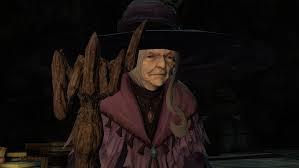
"Mentor" my ass. If Thancred is Ryne's dad, Matoya is Y'shtola's mom. Matoya made this list for the sole reason that she made Y'shtola grow up in a damn cave. Why? Why a dark cave? It's ok if Matoya didn't want to go back to anything related to Sharlayan. There are plenty of other places to take your protegé. That said, even though she speaks harshly she loves Y'shtola. She gripes, but she always helps Y'shtola and her friends. She's never like "you're an adult now, piss off." She worries about Y'shtola's health. It could have been worse.
#5: Julyan Manderville

She's a loving and doting mother, until someone indicates she's old. Then it's lights out. With a frying pan. Have you ever held a cast iron pan? No wonder Gilgamesh went through the wall. Girl is slinging brain damage left and right for the sin of assuming she's over 21. Even though she has an adult son. She booted her son over a continent. No really, a literal continent. I'd call that terrible abuse except... you know, Hildebrand and all that... not like he can die.
#4: Cahciua

There's no doubt that Cahciua loves Erenville. However, she was the mom who dumps her kid on friends and relatives so she can maintain her pre-baby lifestyle. Lady you chose to have a kid. You have to adapt. A kid-free lifestyle is unattainable when you have a kid. She strikes me as the type to have a kid for the "adventure" of raising a kid, then they don't do any of the work but still go on about how hard parenthood is.
#3: Teeshal Ja

This lady. She genuinely thought she could baby-trap Zoraal Ja. Bitch, how dumb can you be. I still want to know if for her "boon" she actually asked to have sex with him, or just requested his splooge and made a clone. Either way, Gulool Ja was a means to an end for her, not a beloved son. That said, she didn't toss him in the trash when Zoraal Ja left, and she made an effort to hide him from danger so she's not as awful as she could have been.
#2: Athena:

Holy hell where to begin. She had a kid with a guy she used for power. While most parents want the best for their kids, Athena very deliberately made her son wimpy and compliant. She never loved Erichthonios. To her, he was a specimen. Had she achieved godhood, she would have tossed him in the trash without a second thought. Her last moments were spent telling Erichthonios "ew, you're so useless." Bitch. You deserve to spend eternity in a room full of voice #4 lalas.
#1: Asahi's mom/Yotsuyu's aunt

I started this list thinking Athena would be the obvious winner. But then I remembered this sack of shit. She sold her adopted daughter into prostitution. She didn't feed her. At the end, she had absolutely no remorse about how she treated Yotsuyu. Hell, her last words to Yotsuyu were like "ugh, why don't you just die already? That would be so much more convenient for me!" And it's not just Yotsuyu. She also raised Asahi. You know, the little shit. She raised him to be a little shit. She taught him that abuse and neglect are fine. She utterly failed at both kids she raised. Here's why she's worse than Athena: the Athenas of the world commit "big" crimes that get talked about. This bitch doesn't even get a name. No historian will look at Yotsuyu's crimes and mark down the actions of the woman who raised her. Her cruelty is insidious and silent in comparison to big world events, and because of that this kind of cruelty is widespread and goes unpunished. The Yotsuyu's Moms of the world have caused more collective harm to humanity than one-off psychos like Athena. This cunt deserves to spend eternity in a room full of voice #5 miqo'tes. All bards. All going WAO! WAO! WOOOO! WOO! like a damn police siren. All day. And when they are not waoing, they are playing shitty off-key midi songs, and all of them are slightly out of sync in the song. You deserve it.
#ffxiv#maybe someday I'll do shitty dads#master matoya#cahciua#julyan manderville#teeshal ja#ffxiv athena#ffxiv yotsuyu
8 notes
·
View notes
Text
Okay now that my other ROTTMNT OC Ronin has been introduced in my series, I’m just going to answer some questions that were asked about him on my instagram but didn’t show because I wanted him to be a surprise or something like that 😅
HERE ARE THE QUESTIONS:
1) What species of turtle is he?
ANSWER: Like I said when answering this for Adriaen, I didn’t have a specific species in mind when I created him. But after remembering that the others are different species I decided to pick a species that I thought suited him. He’s a diamondback terrapin
2) What kind of weapon does he use and what abilities does it have?
ANSWER: He wields a single sword. Not a katana like Leo, but the sword Ronin uses is called a wakizashi I think??
As for its abilities, it’s simple and yet efficient. He is able to make his sword appear endlessly. It’s kinda like Gilgamesh from Fate where he can summon endless weapons. But in Ronin’s case it’s just the one sword. If Ronin is extremely wounded or tired he won’t be able to make his sword appear.
3) What’s personality like?
ANSWER: Ronin is sly and cunning, but he’s also pretty laid back and is somewhat similar to Leo in a way. He likes causing mischief and often teases his opponents. However he’s also smart and strategic, he’s the type to team up with people that could benefit him. He’s not totally loyal to just one group as he has betrayed tons of times. Deep down though he’s a good guy, he just needs time and someone to put him on the right path.
4) Would he be in the other TMNT universes?
ANSWER: Like I said when answering this for Adriaen, I never really thought about him in the other universes but I don’t see why not
5) Is he related to the others?
ANSWER: No, he’s not related to any of the turtles. He is however related to someone but I won’t say who yet
6) Is he close to anyone?
ANSWER: Not really particularly close to anyone but he may have a soft spot for Mikey (and the others really)
7) What is he like in the apocalypse?
ANSWER: Pretty much the same as is now. He does show up kinda whenever and helps defeat the Krang or whoever they’re fighting at the time. It annoys Leo a lot, especially since these two are considered “rivals”, and because Ronin most of the time steals Leo’s spotlight. He doesn’t stick around long enough before disappearing to who knows where, but he has earned a reputation among the survivors.
8) Does he have trauma?
ANSWER: Probably
Aaaand that’s about it. If you want to know more about him, send me a message of your questions and I’ll answer them!

#rottmnt#tmnt#save rottmnt#unpause rottmnt#rise of the teenage mutant ninja turtles#rise of the tmnt#oc#rottmnt oc#tmnt oc#rottmnt leo#riseroninquestions#leo x male oc#leo hamato#tmnt leonardo#leonardo hamato#rise leo#rise mikey#save rise of the teenage mutant ninja turtles#rise donnie#rise raph
12 notes
·
View notes
Note
Not a vocabulary ask 😅 but I was wondering if lapis lazuli had a special significance for the Sumerians? I remember reading a translation of the Epic of Gilgamesh and the stone pops up in relation to the divine a bit. Or is it simply that lapis lazuli was the gemstone they prized the most?
Hello! Lapis lazuli features frequently in Sumerian literature and appears in many Mesopotamian archaeological sites.
The lapis used in Mesopotamia is one of the clearest pieces of evidence for long-distance trade in that era, given that Mesopotamian lapis comes from mines in what is now northeastern Afghanistan; Afghan lapis has been found as far as Egypt and Mycenae(1,2) but by far the most has been excavated in Mesopotamia.(3) And the decline in frequency of lapis objects in Mesopotamian sites starting in the early second millennium BCE coincides with the breakdown of these networks,(1) contemporaneous with the decline of the Indus Valley civilization that was a major trading partner of Sumer and later Akkad.
In terms of associations, lapis lazuli's main connotation was wealth - possession of a lapis object was only available to the very wealthiest in Sumer, or for use in temples. Most objects from the Sumerian era made of lapis are small, like the eyes inlaid in larger sculptures, or small amulets or trinkets.(1) This is because "lapis lazuli was shipped from Iran to Mesopotamia in the form of small blocks or semi-processed masses."(2) So references to large lapis objects, like Inanna's lapis lazuli chariot that she offers to Gilgamesh in the Epic of Gilgamesh, show their fantastical nature, beyond the scope of what one could actually see in contemporaneous Mesopotamia. Who could be richer than a goddess?
The Bull of Heaven, also featured in Tablet VI, has horns "each [of which] was thirty pounds of pure lapis lazuli / and their cases were two fingers thick" (VI.161-62, Helle (2021) translation), an unimaginable bounty, while also showing the other major symbolism of lapis - the sky. Its blue was associated with the heavens, and the flecks of gold often referred to in literature as embedded in the lapis were the sunlight that shines through it.(1) So it's only appropriate for a heavenly bull to have humongous lapis horns.
For more on lapis in ancient Mesopotamia, see (1) Moorey 1994: 85-91; for how lapis was mined in ancient Afghanistan, including photos & maps, see (2) Tosi & Piperino 1973; and for more on the lapis trade, see (3) Hermann 1968.
95 notes
·
View notes
Note
Is the thing about the only surviving piece of written language being a guy complaining about poor quality copper true or an exaggeration/not the full story?
I’m not sure who told you it’s the only surviving writing in that language, because it’s not even close.
The tablet you’re referring to is the complaint tablet to Ea-Nasir (or, rather, Ea-nāṣir) and it’s real, and funny, and written in cuneiform in a language called Akkadian.
But Akkadian was the most widely-used language in Mesopotamia and its nearby regions for 1000 years! It was the lingua franca of the ancient Middle East/Southwest Asia—even for people whose native language was Hittite or Hurrian or Elamite or Egyptian, Akkadian was the language they used to talk to each other internationally, like Latin was in medieval times (or English is now.) Which means there are loads and loads of Akkadian texts that have been discovered. Thousands. The best-known version of the Epic of Gilgamesh is written in a dialect of Akkadian. There is no shortage of surviving Akkadian texts, and because of this—and because Akkadian was a Semitic language, linguistically related to Hebrew and Arabic—archaeologists are pretty good at reading and deciphering Akkadian.
Other languages were written using cuneiform script too, such as Sumerian, Hittite, Hurrian, Luwian, Elamite, Elbaite, and Old Persian, and even Aramaic sometimes? And there are collections of tablets and stone inscriptions of all of those languages too.
That complaint tablet wasn’t even the only known complaint tablet to Ea-Nasir about his copper!
You might be thinking of this tablet in British Celtic from Bath, the only known piece of writing in British Celtic? (Usually, if only one or a very small number of examples of writing exist, we don’t have the ability to decipher what they say.)
16 notes
·
View notes
Note
Friend Shaped x Heroes May Cry AU:
Izuku makes friends with most of the demons, who in turn help him fight as his Devil Arms. This would be more funny if he's not related to Sparda in any way, but he's just that good with helping them.
He'd then make friends with other humans and try to pair them up to help them both. I'd still go with Mei and Pandora's box as a pair cause why not? Miruko with Gilgamesh seems like a good combo too.
Checks out
21 notes
·
View notes
Text
SET FIVE - ROUND ONE - MATCH ONE

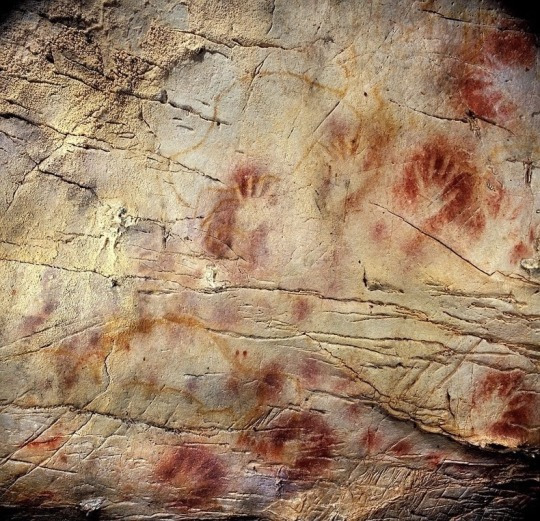
"Cueva de las Manos (Cave of Hands)" (created in several waves between 7,300 BCE and 700 CE) / "Cave of El Castillo" (c. 40,000 BP)
CUEVA DE LAS MANOS (CAVE OF HANDS): To me, it speaks to the vast continuity of humanity and human creativity. People were there and they left behind something of themselves. (cesiousblue) (also submitted by anonymous and jedi-ranger)
CAVE OF EL CASTILLO: these handprints are from el castillo cave in spain. over 40,000 years old. they were made by blowing hand-ground pigments through a hollow reed or bone onto hands placed against the cave wall. for a long time it was assumed that most cave paintings were made by adult men. a recent effort by a group of archaeologists to digitally scan and compile these (and others in nearby cave systems) have shown that about 25% of the handprints belong to children. the process of loading and blowing the pigments was a difficult one, that would have had to be done by an adult. which means that this wall, and others like it, were entirely communal. these were places where adult prehistoric humans took the time to teach their children art. over thirty thousand years before gilgamesh was committed to written language. humans were committing their children’s handprints to stone. the way they must have valued their families, their communities, their art, to go through the process of making this art with them. and not only that, but just the sheer relatability of the action itself! if you transported 40,000 years in the past you’d have little in common on a high level with the humans you’d find. you can’t really talk about your data entry job with the hunter gatherer. but you’d still get a kick out of blowing ground ochre pigment over your hand onto a cave wall. and they’d get a kick out of helping you do it. humans have always been humans. doesn’t it just make you want to fall to your knees at walmart, how beautiful it all is? (source for nerds who care, like me: https://news.artnet.com/art-world/children-worlds-first-artists-new-study-finds-quarter-prehistoric-spanish-hand-paintings-kids-13-2084734/amp-page) (isawken)
("Cueva de las Manos" (Cave of Hands) is located in Santa Cruz, Argentina and consists of outlines of hands, as well as some depictions of animals and hunting scenes created using various mineral pigments and gypsum on rock. The paintings cover about 60 m × 200 m (200 ft × 650 ft) of the cave.
"Cueva del Castillo" (Cave of the Castle) is located within the Caves of Monte Castillo in Puente Viesgo, Cantabria, Spain. The cave consists of over depictions of human hands, animals, and geometric shapes, including the oldest cave art in the world.)
#prehistoric cave art battle </3#art that fucks you up tournament#polls#atfyu polls#id in alt text#ugh before present. that's 38000 bce. probably#thaaat's archaeology for you!#yes i'm absolutely using current era instead of anno domini what of it
100 notes
·
View notes